Peter De Wint
Peter De Wint (21 January 1784 – 30 January 1849) was an English landscape painter. A number of his pictures are in the National Gallery, the Victoria and Albert Museum and The Collection, Lincoln. He died in London.
Peter De Wint | |
|---|---|
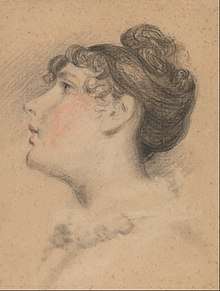 Head of a Girl: Probably a study of Harriet De Wint | |
| Born | 21 January 1784 England |
| Died | 30 January 1849 (aged 65) London, England |
| Occupation | Artist |
| Spouse(s) | Harriet Hilton |
Biography
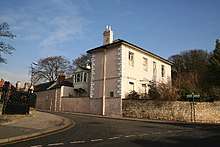
De Wint was the son of an English physician of Dutch extraction who had come to England from New York. He was born in Stone, Staffordshire.
In 1800, William Hilton was apprenticed to the engraver John Raphael Smith, and around the same time enrolled at the Royal Academy school. Another apprentice from 1802 was Peter De Wint, they were inseparable friends. Apprenticed to John Raphael Smith, the mezzotint engraver and portrait painter, he bought his freedom from Smith in 1806, on condition that he supplied 18 oil paintings over the following two years.
In 1806 he visited Lincoln for the first time, with the painter of historical subjects William Hilton, R.A., whose sister Harriet he married in 1810. De Wint and Hilton lived together in Broad Street, Golden Square, where John Varley lived. Varley gave De Wint lessons and introduced him to Dr Monro, who ran an informal academy for young artists.
De Wint often visited Hilton's home in Up-Hill, Lincoln and painted many of his charming landscapes in the district.
De Wint first exhibited at the Royal Academy in 1807, and the following year at the Gallery of Associated Artists in Watercolours. In 1809 entered the Royal Academy schools. He was elected an Associate of the Old Water Colour Society in 1810 and was made a full member the following year. By that time, as an established drawing-master, he was spending his summers teaching well-to-do provincial families. In 1812 he became a member of the Society of Painters in Watercolours, where he exhibited for many years, as well as at the Academy.
De Wint's life was devoted to art; he painted admirably in oils, and he ranks as one of the chief English watercolorists. "No artist", asserted Alfred William Rich, "ever came nearer painting a perfect picture than did Peter de Wint." He frequently visited his wife's home city of Lincoln, and many of his panoramic landscapes and haymaking scenes are set in Lincolnshire. He occasionally toured in Wales, and in 1828 travelled to Normandy.
In Lincoln cathedral is a cenotaph erected by Harriet De Wint (1791–1866) in memory of the two artists - De Wint her husband, and Hilton, her brother.[1]
He was buried in the Hilton family grave in the Savoy Chapel (destroyed by fire on 7th July, 1864). The chapel was restored in 1866 and Mrs De Wint placed a beautiful font in the edifice. Close by a tablet bears the words. 'This font was presented to the Chapel Royal of the Savoy by Harriet De Wint, in place of a Monument previously erected to the memory of her brother William Hilton R.A. her husband Peter de Wint, and other members of her family, whose remains are interred in the adjoining cemetery. The Monument was destroyed by the fire, July VII., MDCCCLXIV. May this tribute be long preserved to the glory of God'. [2]
Gallery
- A Cornfield, by Peter de Wint,1815 (V&A)
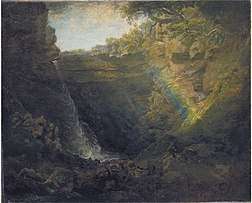 Black Gang Chine, Isle of Wight, about 1843, V&A Museum no. 1036-1886
Black Gang Chine, Isle of Wight, about 1843, V&A Museum no. 1036-1886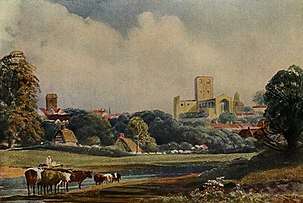 St. Albans by Peter de Wint
St. Albans by Peter de Wint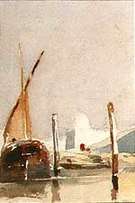 Barque (1816)
Barque (1816)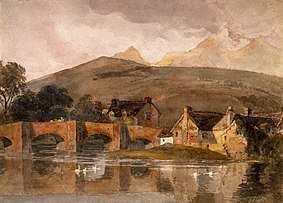 Village by a River
Village by a River
Selected Paintings
32 Works in Tate Britain, including:
- 1810 – Children at Lunch by a Corn Stook, Oil on board – Tate Gallery, London
- 1840 – Roman Canal, Lincolnshire, watercolour on paper – Tate Gallery, London
References
- "William Hilton R.A.". Lincolnshire Echo. 29 December 1921. p. 3.
- "Family grave of William Hilton, Esq, R.A.". Tower Hamlets Independent and East End Local. 12 January 1901.
- David Scrase, Drawings & Watercolours by Peter De Wint, exhibition catalogue, Fitzwilliam Museum, Cambridge (1979)
- Hammond Smith, Peter De Wint 1784–1849, London (1982)
External links
| Wikimedia Commons has media related to Peter de Wint. |
- 59 paintings by or after Peter De Wint at the Art UK site
- Peter de Wint online (artcyclopedia.com).
- Works by Peter de Wint (Tate online)